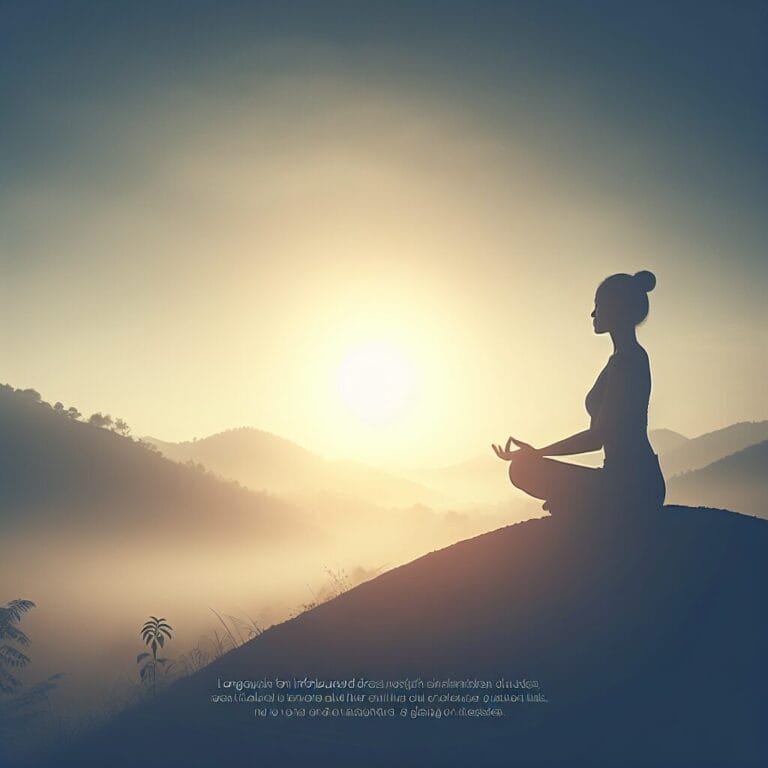
Mastering Mindfulness: Top Relaxation Techniques for Enhanced Mental Clarity
Table of Contents
- Introduction
- Understanding Mindfulness
- Preparing for Mindfulness Practice
- Mindfulness Techniques
- Incorporating Mindfulness into Daily Life
- Overcoming Common Challenges
- Advanced Mindfulness Techniques
- Measuring Progress in Mindfulness
- Conclusion
- Frequently Asked Questions
Introduction
Did you know that your heart can learn to dance at a more soothing rhythm? It’s true! With heart rate variability biofeedback, a relaxation technique not many folks know about, you teach your ticker to beat in a pattern that whispers “calm” all through your body. Imagine being able to tell stress, “Not today!” and mean it. That’s the power of mindfulness practices blended with science – fancy, right? And here’s where it gets super cool: You can even make friends with muscle tension by learning tai chi or autogenic training. These are like secret handshakes that let your muscles know it’s time to chill out. Plus, they’re fun and can even lead to pain relief! Mindfulness for mental clarity is like having a magic wand for your mind; one swish and flick and you can reduce stress, improve sleep, and wave goodbye to those pesky anxiety disorders. So why not give it a try? Your brain will thank you with crystal clear thoughts ready for any adventure!
Understanding Mindfulness
Have you ever wondered how something as ancient as mindfulness has boomed in our fast-paced, high-tech lives? Once upon a time, mindfulness practices were tucked away in quiet monasteries, but now they’re part of the hustle and bustle, helping modern folks find some much-needed peace. It’s like digging up a treasure that’s been right under our feet all along! This gem from the past is super handy today because it’s like having an off-switch for your brain when it gets too crowded with worries and to-dos.
The rise of mindfulness into the spotlight isn’t just because it feels good; science is giving it a thumbs up too! Researchers studying the brain are like detectives uncovering clues about how relaxation therapy can help us lead happier lives. They’ve found that regularly hanging out with mindfulness can change our brains in ways that make us less stressed and more chill. Think of it as sending your mind to the gym – with every mental rep, you’re flexing your relaxation response rather than your fight-or-flight muscles.
And get this – relaxation techniques aren’t just for stress relief; they’ve got superpowers for your physical health too. Guided imagery and breathing techniques can help reduce symptoms of irritable bowel syndrome, which is no small feat! Plus, folks who practice tai chi might notice fewer achy muscles because this gentle exercise tells muscle tension to take a hike. It’s like telling those muscles to sip on some lemonade and enjoy the sunshine!
So while mindfulness may have been around since forever ago, we’re only now understanding how cool it really is. With each new study comes another high-five for mental health champions who encourage us to dedicate some daily time to these ancient arts turned modern-day medicine. And hey, if embracing these practices means getting better sleep and saying “see ya!” to anxiety disorders, why wouldn’t we want to jump on this feel-good bandwagon?

Preparing for Mindfulness Practice
Setting the stage for mindfulness isn’t just about sitting quietly; it’s like throwing a party for your brain where stress isn’t invited. Before diving into this mental soiree, it’s key to lay out what you want from it. Clear intentions are your VIP pass to getting the most out of each mindfulness moment. They’re like setting the destination on your mind’s GPS – whether it’s aiming for less muscle tension, pain relief, or waving goodbye to that fight-or-flight response that loves crashing our calm.
Creating a nook that whispers “relaxation” is another must-do. This space could be anywhere you can feel comfy and undisturbed, with maybe a plant or two to keep you company. Picture this: soft light filtering through the room while you sink into relaxation techniques, guided imagery painting serene scenes in your head, or breathing techniques slowing down those zooming thoughts.
And oh! Timing is everything – carving out regular chill-out sessions sends irritable bowel syndrome packing and helps improve sleep quality. It tells your body and brain, “Hey, get ready; we’re about to switch off stress!” Maybe that means tai chi at sunrise or autogenic training as you wind down from the day. These practices aren’t just stops along the way; they’re journeys toward a more relaxed state where mental health blooms like spring flowers after winter snow.
So there you have it: set clear intentions, craft a haven for tranquility, and clock in some dedicated downtime. Mindfulness isn’t just a practice; it’s an adventure where every step leads to discovering how awesome feeling relaxed can truly be!

Mindfulness Techniques
Have you ever pictured your mind as a superhero, zooming in to save the day with laser-sharp focus? That’s what Mindfulness for mental clarity can turn your brain into – an unbeatable champion against the chaos of everyday life. But wait, there’s more to this story! Let’s talk about some supercool techniques that give your mind those powers.
Mastering various breathing exercises is like having a secret weapon hidden up your sleeve. Imagine taking deep breaths, feeling your belly rise and fall like ocean waves – it’s called diaphragmatic breathing, and it’s pure gold for kicking stress out of town. You can also try alternate nostril breathing; it’s like having a magic switch to balance out all that’s going on up there in your head space.
Ready for another awesome trick? Body scan meditation is where it’s at! Picture lying down and tuning into each part of your body so tightly that even muscle tension doesn’t stand a chance. It starts from the tips of your toes and works its way up, saying “goodbye” to any ache or pain along the way. Neat, huh?
But let’s not stop there! Guided imagery can whisk you away on a mini-vacation right in the middle of a busy day. Close those peepers and let relaxation therapy paint peaceful pictures in your mind — maybe you’re chilling by a babbling brook or lounging on cloud nine. Either way, you’re scoring serious relaxation points.
And hey, who says sitting still is the only way to mindfulness? Not us! Slide some mindful movement into your day with yoga stretches that make muscles merry or tai chi moves that flow smoother than any dance routine you’ve seen. Even walking meditation has its groove; every step becomes a beat in the rhythm of relaxation.
These aren’t just random activities; they’re part of stress management that packs a punch. By inviting these practices into our lives, we bolster mental health and nurture physical health too – because when our minds chill out, our bodies say “Thanks!” It’s all about finding that relaxed state where we function best.
So next time life throws lemons at you faster than you can catch ’em, remember these nifty mindfulness practices are like making lemonade without even needing sugar – naturally sweet relief from whatever comes your way!
Incorporating Mindfulness into Daily Life
Did you ever think munching on your meal could be a secret relaxation technique? That’s right, mindful eating is like a double-whammy for your well-being. It’s not just about scarfing down your lunch; it’s about savoring each bite and truly experiencing the flavors. By paying close attention to what you’re eating – maybe it’s the zesty tang of an orange or the cozy warmth of mashed potatoes – you can reduce stress and even improve digestion. It turns every meal into its own kind of chill-out session!
But wait, there’s more good stuff where that came from – how about we tune our ears with mindfulness too? Mindful listening is like giving someone a big ol’ mental hug. It means really hearing what folks are saying without letting your mind race ahead or get tangled in muscle tension. This stress relief trick can make pals feel super special because they know they’ve got all of your attention.
Let’s not forget talking! Yep, mindful speaking is part of this cool club as well. It’s all about sharing words that dance out of your mouth with care and kindness — so no one ends up with hurt feelings or misunderstandings. Whether it’s chatting with friends or calming an irritable sibling, choosing gentle words can relieve stress for everyone involved.
So next time you chow down, have a heart-to-heart, or share some news, remember these can be awesome moments for practicing mindfulness. They’re fun ways to boost mental health and create a relaxed state that makes every day brighter!
Overcoming Common Challenges
Picture your mind as a playful pup, full of energy and sometimes a bit too much excitement. To help it sit still and behave, we need cool tricks up our sleeves, right? That’s where managing distractions during mindfulness practice comes into play. Instead of chasing its tail with every ping from our phones or buzz of thoughts, we can teach our minds to ‘stay’ using nifty strategies like setting boundaries with technology and creating quiet zones where peace rules the roost.
Keeping our expectations in check is super important too – like knowing that it’s okay if our mind wanders off or if some days feel less zen than others. It’s all part of the ride! And hey, consistency is key; it’s how this Mindfulness for mental clarity journey turns into a habit. Imagine it like brushing your teeth – you do it daily without fail because you know it keeps those pearly whites shiny. Same goes for mindfulness; a little bit every day keeps the stress monsters at bay!
So let’s keep building those mental muscles by sticking to our practice even when life tries to distract us with sparkly things. By blending these fresh perspectives with relaxation techniques and mindfulness practices, we create a relaxed state that makes every day feel like a high-five for our well-being!
Advanced Mindfulness Techniques
Dive into loving-kindness meditation, a heartwarming addition to your stress management toolkit that can soothe the soul and spread sweetness through every fiber of your being! Picture it: you’re sending out waves of warm fuzzies to friends, family, and even folks you haven’t met, like planting little seeds of joy wherever your thoughts roam. This relaxation technique isn’t just about feeling good; it’s about growing big ol’ gardens of compassion that could transform irritability into smiles—now wouldn’t that be something?
Zazen—a cornerstone practice in Zen Buddhism—invites you to sit down with yourself in a way that’s deeply grounding. Time spent in Zazen is like giving the hustle and rustle of life a time-out so you can just “be.” It strengthens the relaxation response while the world buzzes by at its usual breakneck pace.
Then there’s Vipassana meditation, an ancient exercise for mental clarity where each breath helps dust off your inner mirror. As you focus on sensations within the body, layer after layer of mental clutter gets cleared away. Before long, you’re seeing life through a lens polished by mindfulness practices—a view where everything sparkles with clarity. These time-honored techniques connect us to traditions that have nurtured mental health and physical well-being for centuries—they’re tried-and-true allies against muscle tension and sleep-stealing thoughts, proving once again how powerful peace can be when we make room for it in our busy lives.
Measuring Progress in Mindfulness
Harness the digital age to elevate your mindfulness journey! With a world of apps at our fingertips, blending tech with relaxation techniques is like having a personal zen master in your pocket. These savvy tools can guide you through breathing exercises and autogenic training or immerse you in soothing guided imagery sessions. They’re not just fancy gadgets; they’re your allies in crafting that oh-so-sweet relaxed state. And guess what? Jotting down thoughts in a reflective journal isn’t old-school—it’s your roadmap to noticing how far you’ve come on this path of mental clarity. It’s like giving yourself gold stars for every step towards reducing stress and muscle tension. Plus, don’t shy away from asking pals or family about what they notice since you started your mindfulness practices. Their feedback? Pure gold! It’s one more way to ensure those anxiety disorders, sleep troubles, and even irritable bowel syndrome get the boot, making room for improved mental health and physical health. Why not click “download” on this adventure and see where it takes you?
| Tool/Method | Description | Purpose | Benefits |
|---|---|---|---|
| Mindfulness Apps | Apps that guide through breathing exercises, autogenic training, or offer guided imagery sessions. | To provide accessible mindfulness guidance and techniques. | Convenience of having a personal zen master; enhances relaxation and mental clarity. |
| Reflective Journal | A personal journal for recording thoughts, experiences, and progress. | To track mindfulness journey and notice personal growth. | Acts as a roadmap to self-awareness; reinforces positive changes. |
| Feedback from Others | Insights from friends and family about changes they’ve noticed. | To gain external perspective on one’s mindfulness progress. | Validates progress; provides motivation and social support. |
| Physical Health Monitoring | Observing changes in sleep patterns, muscle tension, and symptoms of IBS. | To evaluate the impact of mindfulness on physical health conditions. | Improvement in sleep, reduction in tension, and alleviation of IBS symptoms. |
| Mental Health Evaluation | Assessing changes in stress levels, anxiety disorders, and overall mental well-being. | To measure the effectiveness of mindfulness practices on mental health. | Enhanced mental health and well-being; reduced anxiety and stress. |
Conclusion
Ever wonder how the simple act of coloring can boost your mental mojo? That’s right, grabbing those crayons isn’t just kid stuff—it’s a relaxation technique that works wonders for grown-ups too! When you color, you focus on the here and now, leaving no room for stress or muscle tension. It’s like putting your worries through a paper shredder. Plus, combining coloring with other mindfulness practices—like deep breathing techniques or guided imagery—can turn up the volume on relaxation therapy. So next time life cranks up the pressure, reach for that coloring book and watch as your stressed thoughts melt away like wax, leaving behind a masterpiece of calm in both body and mind. Keep this creative stress relief tool handy; it’s perfect for crafting that relaxed state we all crave!



